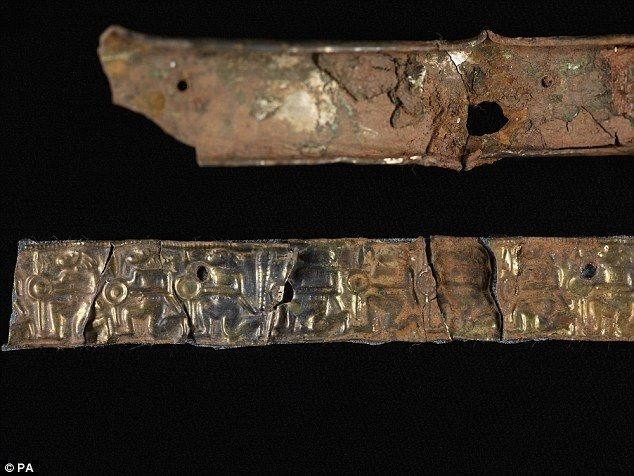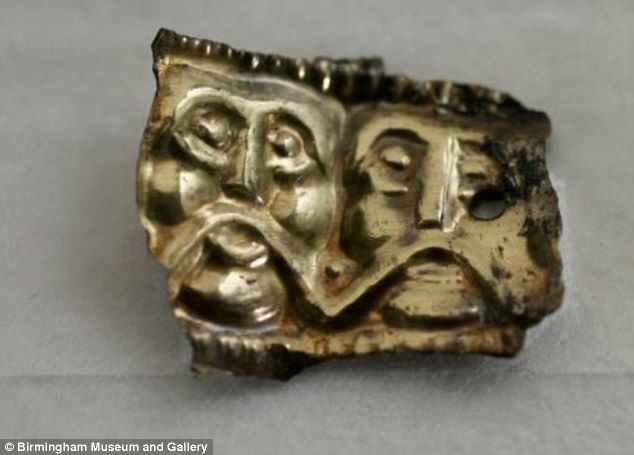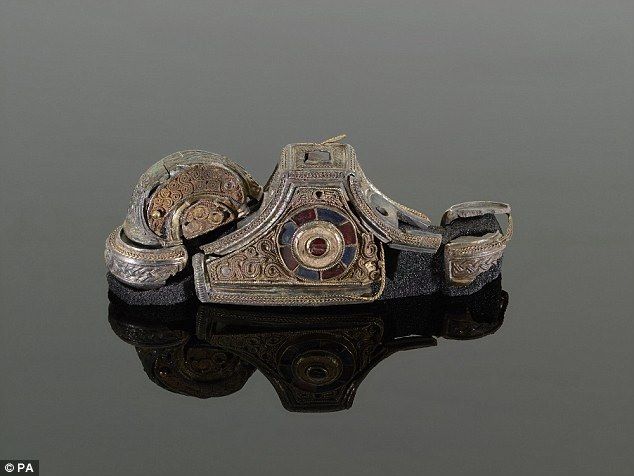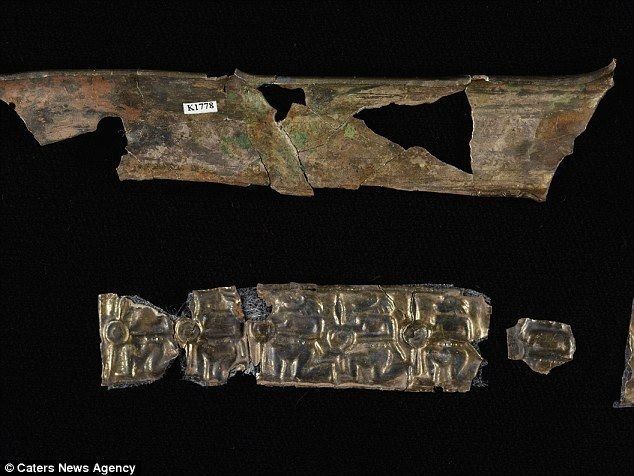Post by UKarchaeology on Sept 29, 2015 12:50:58 GMT
* Helmet was likely made in workshops set up by England's earliest kings
* Archaeologists say only five Anglo-Saxon helmets are known in Britain
* They also pieced together a unique 7th century sword pommel from hoard
* 1,300-year-old treasure found using metal detector in Staffordshire in 2010
Experts studying the incredible Staffordshire Hoard have pieced together thousands of fragments to reveal a rare warrior's helmet and a unique sword pommel.
Archaeologists working with the hoard - the largest collection of Anglo-Saxon artefacts ever found - said the two examples of 7th century 'warrior splendour' were likely made in workshops set up by some of England's earliest kings.
The silver helmet is not yet completely constructed but includes ear pieces, most of the cap and the crest.
And its band reveals etchings of animals and kneeling Saxon warriors, while other parts show men with handlebar moustaches.

Experts studying the incredible Staffordshire Hoard have uncovered a rare warrior's helmet, which includes this helmet band, by piecing together thousands of minuscule scraps of precious metal
Experts worked for three solid days to reassemble some 1,500 thin, fragile silver sheets into parts of the helmet band and other details.
The painstaking job saw these fragments - many measuring less than one centimetre across and making up around a third of the Hoard in size - pieced together to reveal intricate, die-stamped designs, including on the helmet band, which ran around the circumference of the helmet.
Pieta Greaves, who is in charge of the research for the hoard told MailOnline that the detailed band would have been level with the wearer's ears.
The remarkable designs depict kneeling human warriors around the band as well as fragments showing male moustachioed faces, birds, animals and mythical beasts.
But experts have yet to tie them to the helmet.
Some of the warriors depicted have handlebar moustaches, which may hint that the style was fashionable at the time.
She told The Times: 'I don't known what [the find] will tell us about fashion of the period.
'Perhaps being able to groom yourself indicates being part of an elite -they're quite long moustaches, quite handle-bar like.'
Other depictions of warriors on other artefacts are clean shaven or have shaggy beards, suggesting that just like today, men may simply have chosen whether they had a beard or not depending on their personal preferences.
But Dr Greaves said it's possible the images are of ancestral or idealised warriors, intended to give spiritual support to the wearer.

The helmetband, depicting a frieze of warriors (pictured), is part of the incredibly rare silver helmet which is among just five previously known in Britain

Some of the warriors depicted show Anglo Saxon warriors with handlebar moustaches. It may hint that the style was fashionable at the time. Experts are unsure if this piece is from the helmet or not

Researchers have also uncovered a unique sword pommel made up of gold, silver, garnet, glass and deliberately blackened silver niello work (pictured)
She explained that similar men with handlebar moustaches are known on other Anglo Saxon objects such as a drinking horn from Sutton Hoo, suggesting they could have been used to represent an ancestor or figure from a legend.
'The helmet obviously belonged to someone of huge important, such as a king,' she said.

The designs depict kneeling human warriors around the band (pictured) as well as fragments showing male moustachioed faces, birds, animals and mythical beasts. Another part of the helmet is shown above

There are more than 70 pommels in the hoard, but the newly constructed artefact has been described as ‘exceptional’ and is the first of its kind to be found. This is the back of the pommel
(pics at source: www.dailymail.co.uk/news/article-3096905/Experts-piece-rare-Anglo-Saxon-warrior-s-helmet-scraps-precious-metal-Staffordshire-Hoard.html )
* Archaeologists say only five Anglo-Saxon helmets are known in Britain
* They also pieced together a unique 7th century sword pommel from hoard
* 1,300-year-old treasure found using metal detector in Staffordshire in 2010
Experts studying the incredible Staffordshire Hoard have pieced together thousands of fragments to reveal a rare warrior's helmet and a unique sword pommel.
Archaeologists working with the hoard - the largest collection of Anglo-Saxon artefacts ever found - said the two examples of 7th century 'warrior splendour' were likely made in workshops set up by some of England's earliest kings.
The silver helmet is not yet completely constructed but includes ear pieces, most of the cap and the crest.
And its band reveals etchings of animals and kneeling Saxon warriors, while other parts show men with handlebar moustaches.

Experts studying the incredible Staffordshire Hoard have uncovered a rare warrior's helmet, which includes this helmet band, by piecing together thousands of minuscule scraps of precious metal
Experts worked for three solid days to reassemble some 1,500 thin, fragile silver sheets into parts of the helmet band and other details.
There are more than 70 pommels in the hoard, but the newly constructed artefact has been described as ‘exceptional’ and is the first of its kind to be found.
It was reformed from 26 pieces and while Anglo-Saxon in Style, it has British or Irish art influences.
Its central garnet and glass inlaid disc can be seen to form an early Christian cross and on the other side is a motif formed of three serpents, representing both Christian and pagan beliefs.
Most unusual is the rounded hump on the pommel’s shoulder, known as a ‘sword-ring’ – there would have been two originally, one on each shoulder.
Many swords from this period in England and Europe have such rings, but the hoard pommel is the first to have had two.
This, with its lavish ornament, points to it possibly belonging to an individual of significant status.
It was reformed from 26 pieces and while Anglo-Saxon in Style, it has British or Irish art influences.
Its central garnet and glass inlaid disc can be seen to form an early Christian cross and on the other side is a motif formed of three serpents, representing both Christian and pagan beliefs.
Most unusual is the rounded hump on the pommel’s shoulder, known as a ‘sword-ring’ – there would have been two originally, one on each shoulder.
Many swords from this period in England and Europe have such rings, but the hoard pommel is the first to have had two.
This, with its lavish ornament, points to it possibly belonging to an individual of significant status.
The painstaking job saw these fragments - many measuring less than one centimetre across and making up around a third of the Hoard in size - pieced together to reveal intricate, die-stamped designs, including on the helmet band, which ran around the circumference of the helmet.
Pieta Greaves, who is in charge of the research for the hoard told MailOnline that the detailed band would have been level with the wearer's ears.
The remarkable designs depict kneeling human warriors around the band as well as fragments showing male moustachioed faces, birds, animals and mythical beasts.
But experts have yet to tie them to the helmet.
Some of the warriors depicted have handlebar moustaches, which may hint that the style was fashionable at the time.
She told The Times: 'I don't known what [the find] will tell us about fashion of the period.
'Perhaps being able to groom yourself indicates being part of an elite -they're quite long moustaches, quite handle-bar like.'
Other depictions of warriors on other artefacts are clean shaven or have shaggy beards, suggesting that just like today, men may simply have chosen whether they had a beard or not depending on their personal preferences.
But Dr Greaves said it's possible the images are of ancestral or idealised warriors, intended to give spiritual support to the wearer.

The helmetband, depicting a frieze of warriors (pictured), is part of the incredibly rare silver helmet which is among just five previously known in Britain

Some of the warriors depicted show Anglo Saxon warriors with handlebar moustaches. It may hint that the style was fashionable at the time. Experts are unsure if this piece is from the helmet or not

Researchers have also uncovered a unique sword pommel made up of gold, silver, garnet, glass and deliberately blackened silver niello work (pictured)
She explained that similar men with handlebar moustaches are known on other Anglo Saxon objects such as a drinking horn from Sutton Hoo, suggesting they could have been used to represent an ancestor or figure from a legend.
'The helmet obviously belonged to someone of huge important, such as a king,' she said.

The designs depict kneeling human warriors around the band (pictured) as well as fragments showing male moustachioed faces, birds, animals and mythical beasts. Another part of the helmet is shown above

There are more than 70 pommels in the hoard, but the newly constructed artefact has been described as ‘exceptional’ and is the first of its kind to be found. This is the back of the pommel
(pics at source: www.dailymail.co.uk/news/article-3096905/Experts-piece-rare-Anglo-Saxon-warrior-s-helmet-scraps-precious-metal-Staffordshire-Hoard.html )
